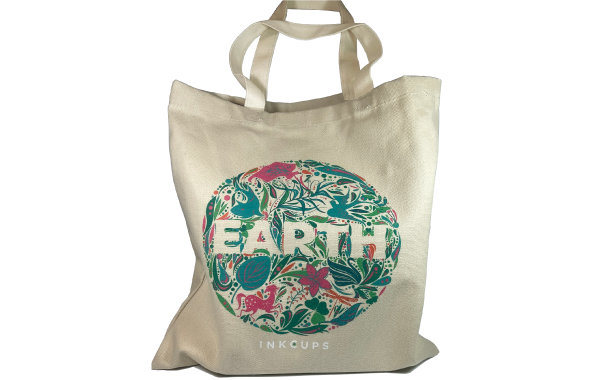- Equipment
- Inks & Supplies
- Services
- Applications
- Tagless
- Resources
- About Us
- Contact Us

Branding on reusable bags proves to be an excellent strategy for promoting your business and fostering brand loyalty, doubling as free advertising when used in unbranded locations—a win-win!
If you’ve ever taken a general art class, whether in high school or at a local community center, you likely tried silk screening, otherwise known as screen printing. While hand silk screening may seem distant from industrial methods, they share surprising similarities. Industrial silk-screening machines, like their handheld counterparts, create art effectively. Silk screening at home offers a cost-effective and enjoyable way to explore this unique art form, while industrial screen printers handle high-quality output.
Both industrial silk screen machines and UV digital flatbed printers are sought-after methods for decorating totes and reusable bags. The demand for custom reusable totes varies—from small runs for bachelorette party favors to large quantities for trade show giveaways or grocery store stock. Screen printing on bags was once a top choice for decoration until digital UV printing entered the scene.
Screen printing and UV printing are distinct methods with a shared goal. In 2023, both have industrial options catering to diverse customer needs.
A significant difference between screen printing and digital UV printing lies in the ink used. Digital UV printers utilize CMYK+WV inks, allowing the simultaneous application of all colors. In contrast, screen printing is a step-by-step process where a stenciled design transfers onto a flat surface using ink, a mesh screen, and a squeegee. Each additional color in screen printing requires a separate screen. While digital UV printing is efficient and versatile, screen printing demands a careful layering of colors with distinct screens for each design stage.
Screen printing offers numerous advantages, particularly in the realm of bulk printing where its exceptional cost efficiency stands out as a major benefit. The process boasts a higher quality output compared to digital prints, ensuring a superior result. Additionally, screen printing excels in durability, making it an ideal choice for long-term printing needs. Its versatility extends to various print materials, encompassing glass, wood, textiles, signs, banners, electronics, and more. Another notable advantage is the ease with which specific areas of the print material can be targeted for printing, providing a flexible and precise approach.
However, it’s important to note that screen printing does come with some drawbacks. A primary concern is its considerably higher initial setup cost compared to digital printing, coupled with a lengthier production time. Additionally, limitations in color choices pose another disadvantage, restricting the available palette. Moreover, the substantial amount of ink applied in screen printing can create a raised appearance for the design on the print material, which may not always be desirable. Another drawback is the reduced flexibility for customization when compared to the more adaptable nature of digital printing.
For more information on screen printing, visit: Rise of Reusable Bags: Different Methods for Decoration
Various inks cater to the diverse needs of screen printing, including plastisol inks, water-based inks, and discharge inks. Plastisol inks, preferred for screen printing, stand out for durability, versatility, and user-friendly nature. Composed of PVC and plasticizers, they offer thickness and opacity advantages over water-based alternatives. However, it’s crucial to note that plastisol inks, while excellent for fine details and enduring multiple washes on apparel, have environmental considerations and lack breathability once printed on fabric. Despite being less relevant for reusable bags, plastisol inks still provide a robust solution for achieving intricate prints with a lasting, crack-resistant finish, necessitating careful disposal practices.
One of the most noteworthy benefits of screen-printing ink is the vibrant white print it achieves. For more information, visit: UV White Ink: Screen Printing Quality, Digitally!
UV ink is a crucial consumable for UV printers. During the printing process, when exposed to UV light rays, UV inks undergo a photochemical reaction, triggering instant curing at low energy levels. This eliminates the need for drying time, significantly boosting overall workflow productivity and conserving energy. UV inks are rapidly gaining popularity as a preferred alternative to other inks.
Choosing the right UV inkjet ink for your digital printer is crucial, tailored to the specific product you’re decorating. Specialty inks prove effective when matched with particular substrates. For digitally printing on reusable bags or totes, the XFLEXX Flexible UV Ink series is recommended for its durability and ability to adapt to flexible objects without cracking or distorting the image. This ink series is available in Cyan, Magenta, Yellow, Black, White, and Varnish.
UV ink’s versatility extends to various applications, from plastic and glass to garments and unconventional substrates. Its formulations include hard, flexible, and even edible ink.
Explore the XJET Switch, a UV flatbed printer designed for direct-to-bag printing. Tailored for reusable bags and totes, this innovative machine simplifies the digital printing process. It effortlessly handles diverse applications, including bright white prints on dark fabrics and quick switches between substrates. With four rotating platens, the XJET Switch allows simultaneous loading and unloading, ensuring an efficient workflow. From polyester drawstring bags to soft coolers, this printer offers a straightforward solution for decorating various reusable items, setting a new standard in digital printing convenience.
A key advantage of digitally decorating bags is the ability to forgo additional machines. When digitally decorating a bag, there’s no need for a dryer, and each print is completed in one trip around the inside of the XJET Switch. In contrast, screen printing on bags requires a dryer, with each layer of ink needing drying between steps—a potentially time-consuming process.
While screen printing on bags was once the go-to option, it’s no longer the case. Consider digitally decorating reusable bags for high-quality, vibrant prints that cure instantly. Contact us today to get started.
Back to Blog Home
Add Your Comment